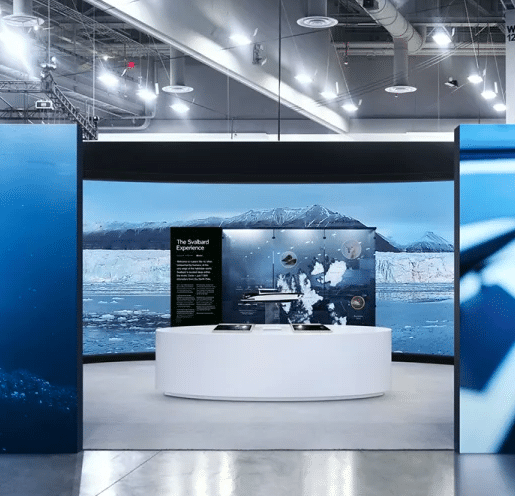“We do things that other agencies just aren’t equipped for”
I would like us to be known for leveraging creativity to help others lean into change rather than be scared or intimidated by it.
 New York, May 8th, 2024
New York, May 8th, 2024
Code and Theory is a strategically driven, digital-first agency that lives at the intersection of creativity and technology. They have 50% creatives and 50% engineers, which allows them to do things that aren’t agencies aren’t equipped for. The agency has worked with clients such as Amazon, Microsoft, JP Morgan Chase and MSNBC.
Stacy Tarver Patterson is the Head of Brand Strategy at Code and Theory. In an interview with TIA, Tarver Patterson went through her professional career that took her to many parts of the world and described her current role at Code and Theory. She also listed the unique features of the agency and gave some examples of their recent work.
In previous interviews, you mentioned growing up on the Jersey Shore and now living in Harlem. How have these diverse environments shaped your perspectives and creative approach?
A lot of my relationships with places that I’ve lived boil down to whether I’ve felt like an insider or an outsider in that place. Even though I spent the first 18 years of my life in Jersey, I probably felt most like an outsider there out of all of the places that I’ve lived. Harlem is on the other end of that spectrum for me, with stints in Portland, Beijing, San Francisco and Shanghai falling in between. I think wearing my “outsider” hat has ingrained in me the importance of reading context clues. In my creative approach, sometimes I ask, “If aliens were to land here right now, how would we explain this concept to them and would they pick up on it?” There’s always good stuff in either the thing that seemingly can’t be explained or the thing that is so obvious that it doesn’t need to be.
You’ve lived in several cities throughout your life, from Manhattan to Portland, Ore., and even Beijing and Shanghai. How have these experiences influenced your work and personal growth?
Living in these various places has taught me the importance of contextualization in how I create, communicate and lead. It’s instilled an instinct in me to quickly map the values, belief systems, shared goals and styles of a new environment and adapt how I work and collaborate accordingly. At a low moment during my time living in Beijing, someone gave me the advice, “It might seem to you like the people around you don’t have any ‘common sense.’ They have common sense, it’s just different from yours.” Ever since then, my hack for quickly understanding the common sense of any given identity group is to look at what’s humorous and what’s taboo in that group’s culture. Brand strategists talk a lot about naming the pains/gains/tears/fears of an audience, but oftentimes, I find “laughs and gaffes” are more useful.
Could you walk us through a typical day in your life?
On a typical day, I wake up around 6:30 and head straight to yoga. I need this to flush out my system, kind of like erasing the whiteboard to start fresh with new space first thing in the morning. I have a short list of intellectual soulmates, and sparring with one of them as I’m walking home from yoga and grabbing coffee is important for me, so I usually make a phone call, send a voice note or fire off the kind of free association text message that is too long for text but too short for email. This is how I both warm up and light up my soul for the day.
In this new world of hybrid, global work, I define work-life balance differently from most people. Growing up a competitive, multi-sport athlete, I’ve never really been a set “on hours/off hours” person. This is especially true for me today. Instead, I find that there’s some mental anchor point or “headliner” appointment in my calendar every day. I try to make sure to include variety and novelty in that marquee booking day in and day out. Sometimes, therapy is the anchor point in my calendar for the day. Sometimes, it is a flight, a big presentation, a hard conversation or a difficult decision at work. But sometimes, it’s a “big walk” with my dog or a race or a show with good friends. If I go too many days without the anchor point being personal, fun or weird, burnout becomes a problem. My days are usually pretty stacked, but as long as there’s good variety across the anchor points, I’m generally satisfied.
What are your main focuses at the moment?
This is the last week of the semester for an MBA course on Inclusive Leadership I helped design and facilitate with Dr. Valerie Purdie-Greenaway at Columbia Business School. At work, I am always obsessing over the rapidly expanding scope and evolving role of modern CMOs and how we help them stay ahead of the curve to navigate changing expectations while resetting a few ourselves. I’m focused on this moment of existential opportunity for agencies in general as we harness our creativity to tell breakthrough stories and orchestrate systems that tell the story through behavior and experience.
Can you tell us about a recent project at Code and Theory that you’re particularly excited about?
Let me start by saying that one of my biggest personal challenges is that I get ‘too excited’ about almost every project I take on. But one recent project that has been meaningful to me is the rebrand of 75-year-old ETS. We were brought on to help reposition the organization (largely known for its TOEFL, GRE and PRAXIS exams), unifying its vast portfolio offerings under one brand narrative that leads the industry into a dynamic future. In a world where traditional education falls short of the holistic talent needed to power the economy of the future, ETS bridges the gap between skills and opportunity. They are expanding their services to get closer to the area of impact: future readiness. That’s the real purpose of ETS, and the role Code and Theory played in aligning businesses, institutions and societies in that purpose really fills my cup.

You’ve been able to collaborate with so many brands in your career, but what mistakes have you seen from companies trying to stay relevant?
Community has been a red thread throughout my career and even earlier as an athlete and a YMCA kid. Too often, brands approach the community as a channel rather than as a service. As trust in other groups and institutions erodes, brands have stepped up to fill the void. But I wish that more brands would embrace servant leadership instead of surface tactics in doing so.
Are there any specific industries or sectors that Code and Theory is particularly passionate about working with or contributing to?
We are unique in that we are 50% creatives and 50% engineers at scale. It gives us the ability to do things that other agencies just aren’t equipped for. So I’d say there aren’t specific industries or sectors, but I do think there are particular “transformation archetypes” that we get excited about helping to infuse with technology and systems thinking. The first is clients who are making the transition from cost-center marketing to ROI-accountable systems and models. Related to this, our sweet spot is in helping brands move from a funnel mentality to designing holistic, self-strengthening CX flywheels. We also enjoy marketing model shifts from campaign journeys to habit loops, evolving toward an “upward spiral” mentality. And lastly, it’s always mutually fulfilling to help brands transition their customer engagement culture from one of buying to one of buying into.
Your tenure at Nike, particularly leading promotional ventures in China, must have been incredibly dynamic. What were some key learnings from your time at Nike that continue to influence your approach to branding and strategy?
That culture eats strategy for breakfast. Present-day headlines aside, Nike understands this more than most. Having an employee base that is so bought into the brand mission and vision results in an ownership mentality that can drive any initiative. This may point to a bias that I have, but working around a lot of team sports athletes makes me appreciate excellent role players. When I spent a few years in Greater China with Nike, it felt like I was being handed the cheat codes of digital marketing’s future. This taught me to prioritize a portfolio mentality with how global brands approach their capabilities in regions.
Looking ahead, what are your aspirations for Code and Theory in the coming years, and how do you envision the agency’s role in shaping the future of branding and digital productions?
My aspirations for Code and Theory include leading the way toward a new kind of creative agency model that businesses partner to stoke systemic change and accelerate toward a more user-centric, first-party data-led world. We’ll leverage our knowledge of behavioral economics in the digital realm with real-world insights to foster a culture of anticipation with our clients. I would like us to be known for leveraging creativity to help others lean into change rather than be scared or intimidated by it.
Can you share your thoughts on using artificial intelligence in your creative work?
As I get older, I continue to learn that an individual cannot scale, so I am for anything that can augment, amplify or even de-bias our own unique creative processes. It’s amazing how quickly it’s become our instinct to at least leverage genAI for three F’s: a first draft, a filtering mechanism or a tool for f***ing around.
Do you think someone can get into the field without educational experience in a school environment?
Yes. Exercise curiosity every day and be relentless in your pursuit of understanding what motivates people. Learn a skill or technology that is in demand on the client side, ideally where there is short supply, and infuse your creative process with it. Start a business or lead and grow a community. Focus on delivering results that speak louder than a degree would. Right now there is a lot of tension about how to reimagine creativity, team collaboration and innovation in a hybrid or remote working environment. There are many new best practices to be discovered and adopted — you could invent or align yourself with one of them.
Were there any books, movies, or works of art from your early life that left a lasting impact on you or fueled your imagination?
A Whole New Mind: Why Right-Brainers Will Rule the Future by Daniel H. Pink.
Are there any hobbies or activities outside of design that you enjoy and find inspiration from?
If sticky notes were a sport that would be my top. I love collecting ideas, quotes, insights, questions, paradoxes or sketching out frameworks. I probably do this more in my personal life than I do in my work life. It’s a habit that serves my work life pretty well. Actually, I have a portfolio of “selves” across different aspects of life that are important to me. These stickies are my way of connecting everything on the backend because I don’t keep different notebooks for different purposes or partition my Post-its at all.

As someone who enjoys challenges, is there any lesson you’ve had to learn multiple times?
Yes — not to draw my worth from my work (company, role, title, salary, accolades, team size) but that it is okay to identify with what I bring to my work. Right out of college, I was a personal trainer, and I fell in love with the feeling of changing people’s minds about what they thought they could make possible for themselves. Even though my work is very different these days, I’m still just following that feeling.
Please share a fun-fact that not many people know about you.
I love the kids media company, GoNoodle. They make short guided dance and exercise videos for little kids. I don’t have kids of my own, but during COVID lockdown, many of my friends and family members with little ones were playing these videos to make up for missed physical education. The songs are catchy, and it feels good to dance and jump and be silly. I think I enjoy playing along with these videos even more than my nieces and nephews do.
Stacy ’s Working Preferences:
Early Bird or Night Owl?:
Early Bird
Food you can’t live without:
Spaghetti Limone at Lil' Frankies
Most quoted book, TV Show or movie:
Curb Your Enthusiasm
Next travel destiny on your list:
Costa Rica
Favorite type of weather:
72 and sunny, with a breeze that justifies having a jacket
Preferred spot in your town:
Central Park really never gets old. It's like a living poem.
What is something on your bucket list that you haven't done yet?:
I would like to go to a sober rave and experience that vibroacoustic resonance "high."
What makes a good day at work?:
Anytime I am part of a shared epiphany, I feel good.
If you could solve one problem in the world, what would it be?:
Racism. Including the fact that some people refuse to recognize how much of a fundamental problem it is.



















